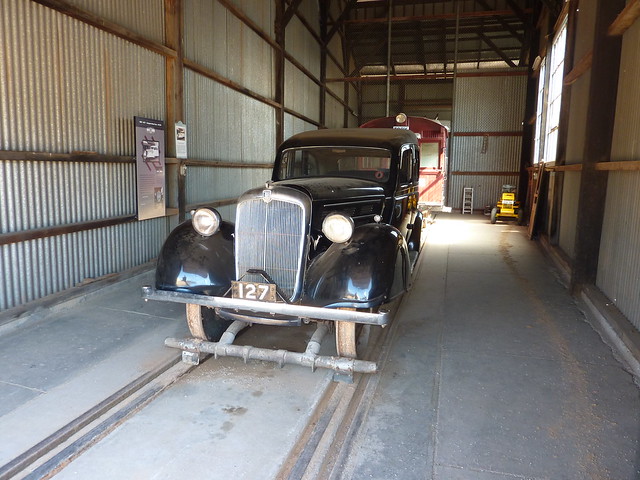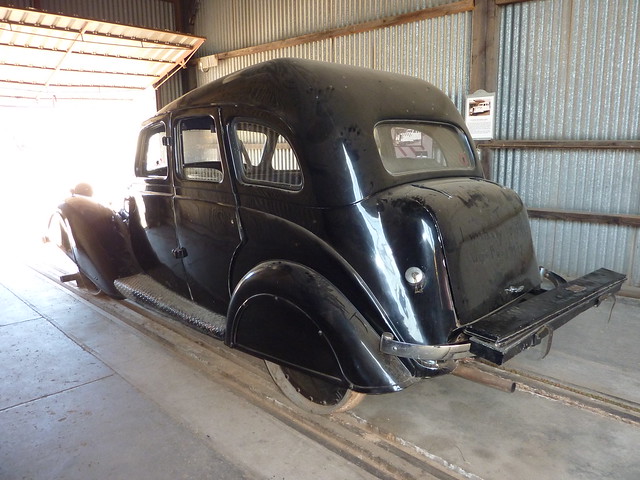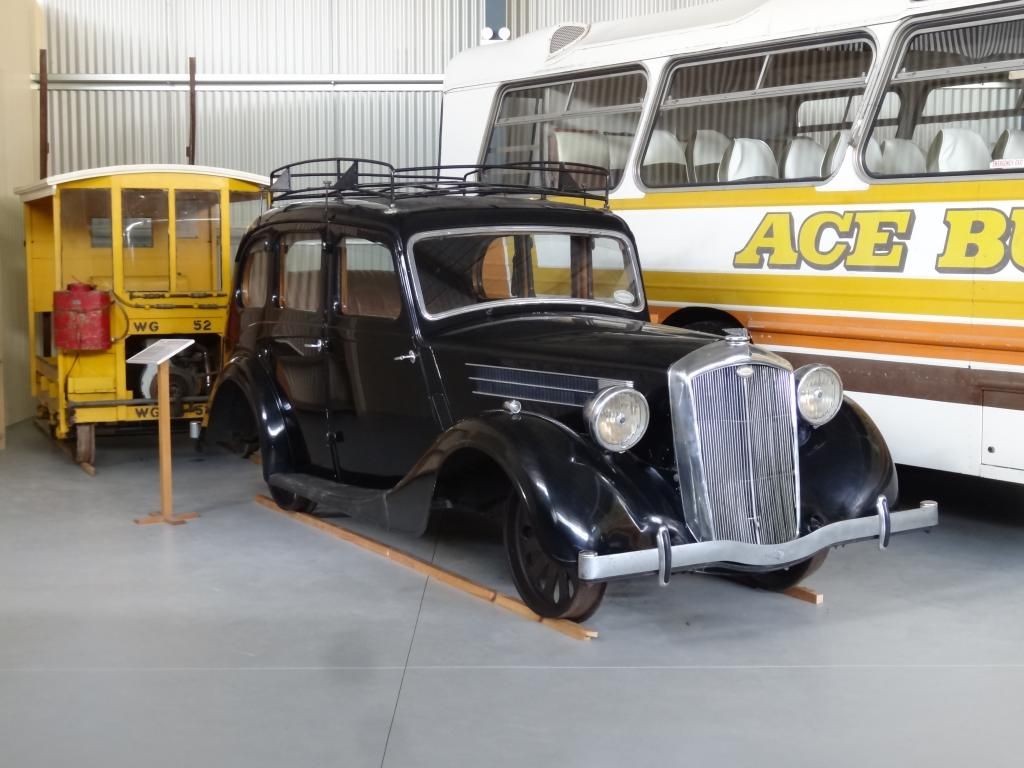- Posts: 3687
- Thank you received: 465
Rail conversions
9 years 5 months ago #143715
by bparo
Having lived through a pandemic I now understand all the painting of fat people on couches!
Replied by bparo on topic Re: Rail conversions
If anyone is near Pichi Richi Railway in Quorn they had a Dodge like that you used to get shown on their Workshop Tour. It was black and yellow stripes when I last saw it (about 25 years ago).
If you get a chance to do one of their workshop tours it is worthwhile to see what goes on behind the scenes
If you get a chance to do one of their workshop tours it is worthwhile to see what goes on behind the scenes
Having lived through a pandemic I now understand all the painting of fat people on couches!
Please Log in to join the conversation.
9 years 5 months ago - 9 years 5 months ago #143716
by Bobsboy
Mucking about on the edge
Replied by Bobsboy on topic Re: Rail conversions
Hi,
Black and Yellow at Quorn eh?
Better than this particular shade of ah, er, um brown.
(Maybe it was known as "leather" back in the day?
Ya,
Brogenil, pretty good.
Took me near 40 years to get there though.
(I never found that bridge to New Zealand but.)
Silver City Comet - Wikipedia via Google;
www.google.com.au/url?sa=t&rct=j&q=&esrc...vm=bv.80185997,d.dGc
-b
Black and Yellow at Quorn eh?
Better than this particular shade of ah, er, um brown.
(Maybe it was known as "leather" back in the day?
Ya,
Brogenil, pretty good.
Took me near 40 years to get there though.
(I never found that bridge to New Zealand but.)
Silver City Comet - Wikipedia via Google;
www.google.com.au/url?sa=t&rct=j&q=&esrc...vm=bv.80185997,d.dGc
-b
Mucking about on the edge
Last edit: 9 years 5 months ago by Bobsboy.
Please Log in to join the conversation.
9 years 5 months ago #143717
by asw120
“I offer my opponents a bargain: if they will stop telling lies about us, I will stop telling the truth about them”
― Adlai E. Stevenson II
Replied by asw120 on topic Re: Rail conversions
With the Silver city comet, another tie-in to the "vertical commercial vehicle" (lift) industry - a Standard-Waygood generator. Sadly, none left in service in Brisbane. Last one went down with the old Royal Brisbane Hospital. I have pictures.....somewhere. They seem to have made lots of heavy electrical stuff besides lifts. (They were merged with Johns & Waygood).
Jarrod.
Jarrod.
“I offer my opponents a bargain: if they will stop telling lies about us, I will stop telling the truth about them”
― Adlai E. Stevenson II
Please Log in to join the conversation.
9 years 5 months ago #143718
by Mairjimmy
Time to get up andd get going.......todays bad decisions aren't going to make themselves!!!
Replied by Mairjimmy on topic Re: Rail conversions
Here is a rail car that's at Peterborough rail museum SA
Roderick you would have seen this one. I was thinking it is a Wolsley



 but maybe not.. If you are into trains Peterborough is a top place to visit, the guide who show us around was tops
but maybe not.. If you are into trains Peterborough is a top place to visit, the guide who show us around was tops
Colin
Roderick you would have seen this one. I was thinking it is a Wolsley




 but maybe not.. If you are into trains Peterborough is a top place to visit, the guide who show us around was tops
but maybe not.. If you are into trains Peterborough is a top place to visit, the guide who show us around was topsColin
Time to get up andd get going.......todays bad decisions aren't going to make themselves!!!
Please Log in to join the conversation.
- Roderick Smith
-
 Topic Author
Topic Author
- Offline
Less
More
- Posts: 3497
- Thank you received: 307
9 years 5 months ago - 9 years 5 months ago #143719
by Roderick Smith
Replied by Roderick Smith on topic Re: Rail conversions
I was waiting for a chance to say something adding to content, and not just 'Thanks for the great photos'. The recent additions have been excellent, and I enjoyed learning about the link to lifts/elevators.
Bush Tramway Club's website is: <www.bushtramwayclub.com>. In common with Australian timber tramways: operation was 'shoestring' with lots of weird improvised homebuilt equipment.
The Broken Hill one seems to have been repainted recently.
The Peterborough one is a Morris (10?), and was reengined with a Holden (grey?). AFAIK there were two. I have a photo of one in use at Gladstone in 1969, when it was white. It is scanned, and I think cleaned, but is in a queue for posting. I suspect that the other Morris is in National Railway Museum, at Port Adelaide.
Roderick B Smith
Rail News Victoria Editor
Bush Tramway Club's website is: <www.bushtramwayclub.com>. In common with Australian timber tramways: operation was 'shoestring' with lots of weird improvised homebuilt equipment.
The Broken Hill one seems to have been repainted recently.
The Peterborough one is a Morris (10?), and was reengined with a Holden (grey?). AFAIK there were two. I have a photo of one in use at Gladstone in 1969, when it was white. It is scanned, and I think cleaned, but is in a queue for posting. I suspect that the other Morris is in National Railway Museum, at Port Adelaide.
Roderick B Smith
Rail News Victoria Editor
Last edit: 9 years 5 months ago by Roderick Smith.
Please Log in to join the conversation.
9 years 5 months ago #143720
by Dave_64
Replied by Dave_64 on topic Re: Rail conversions
Been following these posts avidly, started looking up "Silver City Comets" and found that before being repowered with "Swishy's Screamers" (read GM 110 series) , they came out originally with in-line 8 cylinder Diesels. Found a tenuous link via Harland & Wolf to the "Beardmore Tornado" engine which were installed in the R101 Airship. Says that the airship version was developed from two original 4 cylinder railcar diesels joined together with a common crank. Fascinating stuff!
Roderick, any chance of confirming if the "Comet" was indeed built with these Beardmore Engines? All I can find out is that it seems that the NSWGR had trouble getting spare parts for the original power units and thus swung over to the 110 G.M's.
Cheers, Dave 64
Roderick, any chance of confirming if the "Comet" was indeed built with these Beardmore Engines? All I can find out is that it seems that the NSWGR had trouble getting spare parts for the original power units and thus swung over to the 110 G.M's.
Cheers, Dave 64
Please Log in to join the conversation.
- Roderick Smith
-
 Topic Author
Topic Author
- Offline
Less
More
- Posts: 3497
- Thank you received: 307
9 years 5 months ago #143721
by Roderick Smith
Replied by Roderick Smith on topic Re: Rail conversions - early engines
This thread also links to others, when we discussed the EMD567; I suspect that we have also discussed the 6/71 (but not its Winton ancestry), and the Gardner range. Alco was early in the railway field, but I don't think hit the truck or ferry markets. Leyland and AEC were prolific in early railmotors: based on bus technology, but not bus conversions. One of the problems with early internal combustion engines for railway applications was excess weight. Another time I'll look at VR's two McKeen cars, c1912. They were too far ahead of their time, and were failures. Into a later era, railmotor technology moved to underfloor 'pancake' engines. Makers included Cummins and Rolls Royce.
From < www.railmotorsociety.org.au/rm_home_master_frame.htm> ;
The 100 class vans were powered by two 330 hp Harlandic 8-cylinder, 2-stroke diesel engines. These engines were built under licence from the Danish shipbuilding firm of Harlandic Burmeister and Wain by Harland and Wolff, shipbuilders of Belfast, Northern Ireland. Starting was by compressed air, assisted by high capacity glow plugs for use in cold weather. Various radiator and cooling fans were driven by bevel gearing from the engine main shaft. The engines were located on the longitudinal centreline of the vehicle and driving towards each end of the vehicle.
In Ireland in 1935, Harland and Wolff constructed a shunting locomotive for Northern Counties Committee (Ireland) of the London Midland and Scottish Railway. This loco used a 330 hp diesel with a Voith hydraulic transmission and it is possible that this vehicle influenced the mechanical equipment used in the power vans...To provide power for lighting and airconditioning, two auxiliary diesel engines were 32 hp 4-cylinder National Diesels, each driving a 22 kW BGE generator at 120 V dc...from 1953, the four surviving power vans were rebuilt with four vertical 250 hp General Motors Detroit Diesel 110 Series Model 62408 6-cylinder 2-stroke engines...Auxiliary power was provided by two 82 hp General Motors Detroit Diesel 71 Series Model 4043 4-cylinder 2-stroke engines...They drove a Standard Waygood GM, 120 V dc, 50 kW generator.
Roderick B Smith
Rail News Victoria Editor
From < www.railmotorsociety.org.au/rm_home_master_frame.htm> ;
The 100 class vans were powered by two 330 hp Harlandic 8-cylinder, 2-stroke diesel engines. These engines were built under licence from the Danish shipbuilding firm of Harlandic Burmeister and Wain by Harland and Wolff, shipbuilders of Belfast, Northern Ireland. Starting was by compressed air, assisted by high capacity glow plugs for use in cold weather. Various radiator and cooling fans were driven by bevel gearing from the engine main shaft. The engines were located on the longitudinal centreline of the vehicle and driving towards each end of the vehicle.
In Ireland in 1935, Harland and Wolff constructed a shunting locomotive for Northern Counties Committee (Ireland) of the London Midland and Scottish Railway. This loco used a 330 hp diesel with a Voith hydraulic transmission and it is possible that this vehicle influenced the mechanical equipment used in the power vans...To provide power for lighting and airconditioning, two auxiliary diesel engines were 32 hp 4-cylinder National Diesels, each driving a 22 kW BGE generator at 120 V dc...from 1953, the four surviving power vans were rebuilt with four vertical 250 hp General Motors Detroit Diesel 110 Series Model 62408 6-cylinder 2-stroke engines...Auxiliary power was provided by two 82 hp General Motors Detroit Diesel 71 Series Model 4043 4-cylinder 2-stroke engines...They drove a Standard Waygood GM, 120 V dc, 50 kW generator.
Roderick B Smith
Rail News Victoria Editor
Please Log in to join the conversation.
9 years 5 months ago #143722
by Dave_64
Replied by Dave_64 on topic Re: Rail conversions
Thanks, Roderick,
Like I said, fascinating stuff! I seemed to be on the right track, just got the info a bit mixed.
Cheers, Dave 64
P.S. I suppose in those dark days, they used whatever the could lay their hands on, whenever they could. Another curiosity was the link between the Napier-Deltic locomotive and submarine engines, not to mention the Crossleys.
Like I said, fascinating stuff! I seemed to be on the right track, just got the info a bit mixed.
Cheers, Dave 64
P.S. I suppose in those dark days, they used whatever the could lay their hands on, whenever they could. Another curiosity was the link between the Napier-Deltic locomotive and submarine engines, not to mention the Crossleys.
Please Log in to join the conversation.
9 years 5 months ago #143723
by Beaver
Beaver@ Museum of Fire
Replied by Beaver on topic Re: Rail conversions
This Wolseley is preserved at the Tasmania Transport Museum at Glenorchy. I think it came from Emu Bay Railway.
Beaver@ Museum of Fire
Please Log in to join the conversation.
9 years 5 months ago #143724
by atkipete
Replied by atkipete on topic Re: Rail conversions
As well as Atkipete climbing into the back, the Pukemiro one has another notable feature. It can do a U turn on rails.
The owner explained how he can jack up the front, unhook the brake linkage from the bogie and push it back till it is under the centre of the truck. Then the jack is lowered till it balances and the truck swung around in its own length. It is jacked up again from the front and the bogie moved back to its correct location.
The owner explained how he can jack up the front, unhook the brake linkage from the bogie and push it back till it is under the centre of the truck. Then the jack is lowered till it balances and the truck swung around in its own length. It is jacked up again from the front and the bogie moved back to its correct location.
Please Log in to join the conversation.
Time to create page: 0.561 seconds


